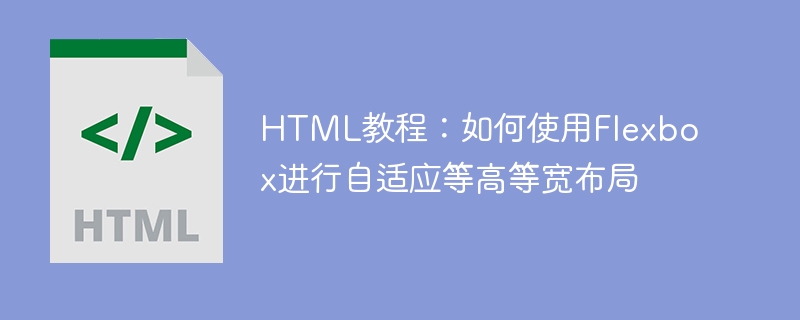

HTML Tutorial: How to use Flexbox for adaptive equal-height and equal-width layout
In modern Web development, page layout is a very important part. Using Flexbox (flexible box layout) can easily achieve adaptive equal-height and equal-width layout. This article will introduce the basic concepts and usage of Flexbox, and provide specific code examples.
1. What is Flexbox
Flexbox is a CSS module used for page layout. By setting the properties of the container and its sub-elements, flexible layout can be achieved. Flexbox-based layouts can adapt to different screen sizes and are very simple and easy to understand.
2. Basic concepts
Before using Flexbox, first understand some basic concepts:
display: flex; attribute. The elements within the container will be laid out according to the specified rules. 3. Use Flexbox layout
The following is a specific example to show how to use Flexbox to implement an adaptive equal-height and equal-width layout.
First, create an HTML file and introduce the CSS file:
<!DOCTYPE html>
<html lang="en">
<head>
<meta charset="UTF-8">
<meta name="viewport" content="width=device-width, initial-scale=1.0">
<link rel="stylesheet" href="styles.css">
<title>Flexbox布局示例</title>
</head>
<body>
<div class="container">
<div class="item">项目1</div>
<div class="item">项目2</div>
<div class="item">项目3</div>
</div>
</body>
</html>Next, set the style of the Flexbox layout in the CSS file:
.container {
display: flex;
flex-wrap: wrap;
}
.item {
flex: 1 1 200px;
height: 200px;
background-color: lightblue;
border: 1px solid black;
}In the above code, We set .container as a Flex container and use flex-wrap: wrap; to implement sub-item wrapping. .item indicates the style of the child item, flex: 1 1 200px; indicates that the remaining space is evenly distributed on the main axis, and the minimum width of the child item is limited to 200px. The height property is used to set the height of the child, and the background-color and border properties are used to set the style.
Through the above code, an adaptive equal-height and equal-width layout can be achieved. No matter how the width of the container changes, the children will automatically adjust to fit the container.
4. Summary
This article introduces the method of using Flexbox for adaptive equal-height and equal-width layout, and gives specific code examples. By flexibly using the properties of Flexbox, various complex page layouts can be easily realized. I hope this article will help you learn Flexbox layout.
The above is the detailed content of HTML tutorial: How to use Flexbox for adaptive equal-height and equal-width layout. For more information, please follow other related articles on the PHP Chinese website!




